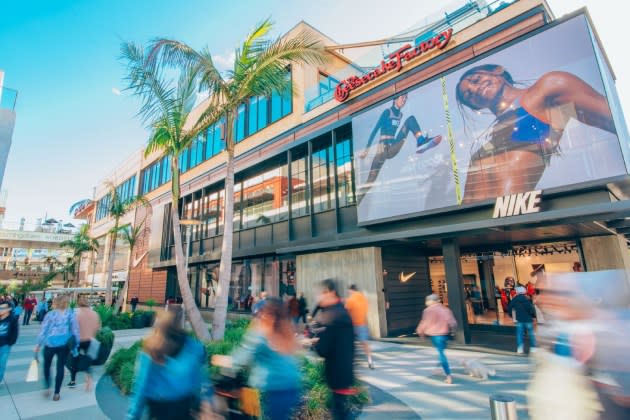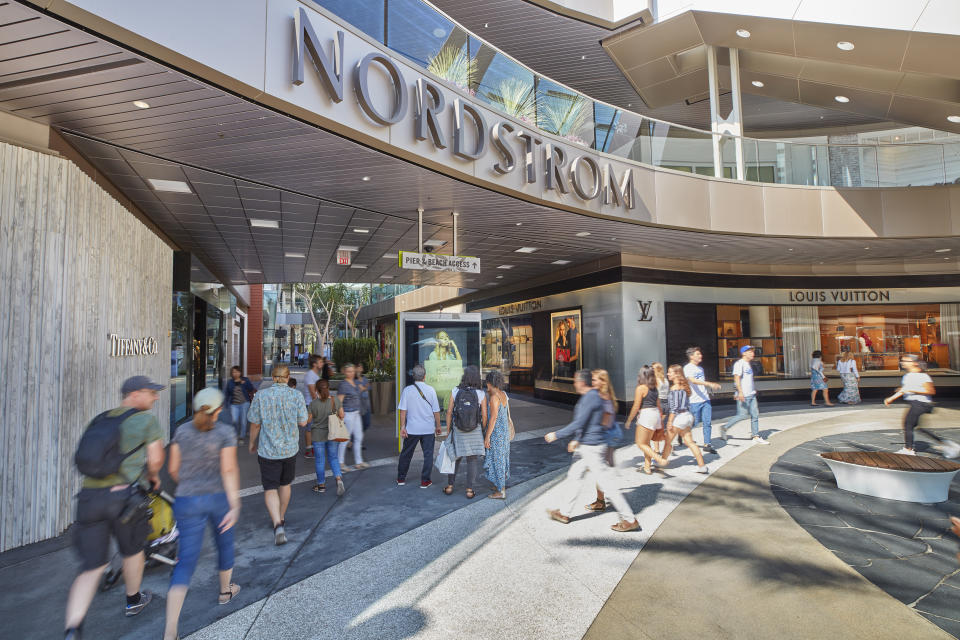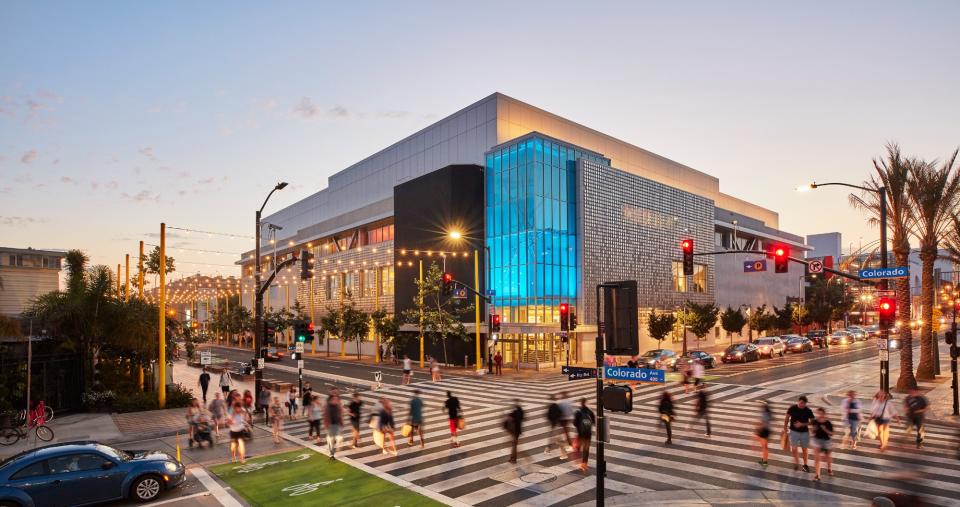Macerich Co. Walking Away From Santa Monica Place, Turning Shopping Center Over to Lenders

When Santa Monica Place opened its mall doors in 1980, it was one of the hottest spots to shop on Los Angeles’ Westside. The enormous shopping center had two department store anchors, 120 shops and top-floor dining where the nearby Pacific Ocean served up killer sunsets.
Before the COVID-19 pandemic hit, the mall in 2019 was 95 percent occupied. Today, that stands at 85.6 percent, not counting anchor stores.
More from WWD
Jordan Bentley Opens Hypland Store in L.A.'s Little Tokyo: A First Look
Silk Laundry Opens First U.S. Store in L.A. With Slipdresses Galore
The pandemic was devastating for the more than 527,000-square-foot mall whose tenants include Nordstrom, Louis Vuitton, Hugo Boss, Nike, Free People, Forever 21 and 7 For All Mankind. COVID pushed the ArcLight Cinema, with 12 screening rooms, to close in 2020, followed by Bloomingdale’s in 2021, whose floors covered more than 100,000 square feet of space.
Santa Monica Place sits at the top of a three-block-long retail stretch known as the Third Street Promenade in the affluent city where houses sell for at least $2 million. The pedestrian-oriented promenade was extremely hard hit during the pandemic with unhoused camping out in store doorways at night and retail theft running rampant, prompting many stores to leave. Restaurants soon followed.
This bleak retail scene has prompted shopping mall giant Macerich Co., which owns Santa Monica Place and whose corporate headquarters are only a few blocks away, to cease payments on the property’s $300 million mortgage loan. It is saying bye-bye to the shopping center it has owned since 1999 and returning it to the lender.
“It was pretty clear that Santa Monica has continuing issues, and it is under water,” said Scott Kingsmore, Macerich’s chief financial officer and treasurer. Kingsmore wouldn’t estimate the mall’s commercial value, but the broker opinion of value for Santa Monica Place is $264.5 million. “Ultimately, trying to figure out the end game was just too obscure,” Kingsmore explained.

The decision to offload Santa Monica Place got a big push earlier this year when Jackson Hsieh joined Macerich as the new president and chief executive, replacing executives who had been there for decades. Hsieh decided the real estate investment trust retail operator needed to take stock of its 43 U.S. shopping centers and classify them into various categories: great, very good, mediocre and bad.
He called them Fortresses, Fortress Potentials, Steady Eddies, and Eddies. Fourteen of those properties were grouped as bad or an Eddy, including Santa Monica Place, with the idea that these retail centers will either be sold, eventually returned to the lenders or improved with some capital.
Right now, Santa Monica Place is the only shopping center being forfeited. Macerich’s new president and chief executive didn’t mince words when talking recently about the iconic mall’s future.
At a Nareit REITWeek conference in New York in early June, he relayed how the shopping center has met with stiff competition from other local higher-end malls. Nearby Westfield Century City, a popular location after a $1 billion remodel in 2017, has tranquil sitting spots with modern outdoor furniture and potted plants, and an array of retailers ranging from Bloomingdale’s and Nordstrom to Macy’s, Banana Republic and COS. It has the only Eataly in Southern California, packed with people shopping for Italian ingredients and dining on pasta. “You have to keep in consideration that Century City has taken their game up tremendously,” Hsieh said.
He also pointed to nearby Palisades Village, a high-end retail project by shopping mall magnate Rick Caruso. It is located in the affluent Pacific Palisades neighborhood where celebrities including Tom Hanks, Rita Wilson and Steven Spielberg live. The outdoor retail venue has a small-town vibe with a small park in the center, a multiplex movie theater, an Erewhon, upscale restaurants and many luxury stores. It is a popular weekend hangout.
“Caruso’s project up in the Palisades continues to bite away at the [Third Street] Promenade [and Santa Monica Place],” Hsieh said.
He noted there is a disparate group of landlords on the promenade. “It’s challenging [there] because it’s a knife fight in terms of leasing,” he said.
Business is so bad on the promenade that Federal Realty Investment Trust recently announced it sold all nine of its properties that housed mostly retail and some office space. It had been a presence there since 1996, but the tough retail environment, where occupancy ranges from 70 percent to 80 percent, wasn’t helping revenues. It sold eight buildings for $103 million.

Macerich, which last renovated Santa Monica Place in 2009 into an open-air space, was working to find new tenants to take over space vacated during the pandemic. To replace the ArcLight Cinema with its 12 screens, the mall owner signed a lease last year with an immersive digital art museum called Arte Museum, based in South Korea. It will feature things like a room with a towering waterfall cascading down the wall complemented with the scent of fresh air. Macerich estimates the museum, scheduled to open in 2025, should attract 1 million visitors a year.
Another new tenant eventually opening is a high-end fitness concept called Club Studio, taking over 47,000 square feet once occupied by the first floor of Bloomingdale’s. With seven fitness studios inside dedicated to cycling, boxing, yoga and Pilates, it is expected to be running by next year. And Din Tai Fung, the popular Taiwanese-owned noodle and soup dumpling eatery, is expected to open on the center’s top floor with 10,000 square feet later this year.
But these projects are arriving too late to the retail venue, whose operations helped push Macerich’s net loss last year to $274 million on $884 million in revenues. In 2022, net loss was $66 million on $859 million in revenues.
Hsieh explained there are several ways to improve the mall. Nordstrom could be replaced with a high-rise residential complex surrounded by entertainment-type establishments and fewer luxury retailers. “It’s a very different set-up than it was 10 years ago,” he said.
He believes someone will be able to make the mall profitable, but it won’t be Macerich. “It’s just not going to be us,” he explained. “It’s going to probably take a lot longer than we’re prepared to wait.”
Best of WWD

 Yahoo Finance
Yahoo Finance